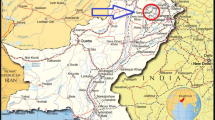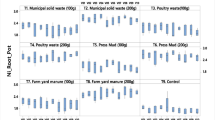Abstract
The cheapest way of disposal of wastewater is its use in agriculture. The pressure in using fresh water resources may be alleviated by the domestic wastewater in agriculture. Wastewater holds significant quantity of plant nutrients like N, P, Ca, K, Co, Zn, and Mn. Therefore, it increases the crop yield. Triticum aestivum is the staple food crop for Pakistan, where it is an important caloric source. It is grown successfully in rain fed areas of the country as well as in irrigated areas with minimum water without losing its production potential. In this study, cadmium (Cd), nickel (Ni), iron (Fe), manganese (Mn), copper (Cu), chromium (Cr), zinc (Zn), and cobalt (Co) were evaluated; the effect of wastewater was studied on wheat variety (Punjab-2011) by applying different treatments of wastewater. In the comparison between five different treatments, in soil, Fe was the highest. The chromium in the current findings exceeded the permissible limit (0.03 mg/kg) in wheat grains. The reason of high Cr concentration might be due to the increased usage of wastewater for long periods. The level of pollution or the factor of contamination was the lowest for Zn and was highest for Cd in all treatments. Chromium has the lowest value of health risk index while Cd has the highest value in all treatments, indicating that exposed population is unlikely to experience obvious adverse effects on utilization of these contaminated grains of wheat.





Similar content being viewed by others
References
Ahmad K, Khan ZI, Yasmin S, Ashraf M, Ashfaq A (2014) Accumulation of metals and metalloids in turnip (Brassica rapa L.) irrigated with domestic wastewater in the peri-urban areas of Khushab city, Pakistan. Pak J Bot 42(2):511–514
Antil RS, Narwal RP (2005) Problems and prospectus of utilization of sewer water in Haryana. In: Kapoor KK, Sharma PK, Dudeja SS, Kundu BS (eds) Management of organic wastes for crop production, Department of Microbiology. CCS Haryana Agricultural University, Hisar, pp 159–168
Asdeo A (2014) Toxic metal contamination of staple crops (wheat and millet) in peri-urban area of Western Rajasthan. Int Ref J Eng Sci 3(4):8–18
Balkhair KS, Ashraf MA (2016) Field accumulation risks of heavy metals in soil and vegetable crop irrigated with sewage water in western region of Saudi Arabia. Saudi J Bio Sci 23(1):S32–S44. https://doi.org/10.1016/j.sjbs.2015.09.023
Bibi Z, Khan ZI, Ahmad K, Ashraf M, Hussain A, Akram NA (2014) Vegetables as a potential source of metals and metalloids for human nutrition: a case study of Momordica charantia grown in soil irrigated with domestic sewage water in Sargodha, Pakistan. Pak J Zool 46(3):633–641
Boularbah A, Schwartz BG, Aboudrar W, Ouhammou A, Morel JL (2006) Heavy metal contamination from mining sits in South Morocco: assessment of metal accumulation and toxicity in plants. Chemosphere 63(5):811–817. https://doi.org/10.1016/j.chemosphere.2005.07.076
Chary NS, Kamala CT, Raj DSS (2007) Assessing risk of heavy metals from consuming food grown on sewage irrigated soils and food chain transfer. Ecotoxicol Environ Saf 69(3):513–524. https://doi.org/10.1016/j.ecoenv.2007.04.013
Cui YG, Zhu YG, Zhai RH, Chen DY, Huang YZ, Qui Y, Liang JZ (2004) Transfer of metals from soil to vegetables in an area near a smelter in Nanning, China. Environ Int 30(6):785–791. https://doi.org/10.1016/j.envint.2004.01.003
Economic Survey of Pakistan (2015) Economic Survey of Pakistan 2015–16. Government of Pakistan, Islamabad
Ekmekyapar F, Sabudak T, Seren G (2012) Assessment of heavy metal contamination in soil and wheat (Triticum aestivum L.) plant around the Çorlu–Çerkezkoy highway in Thrace region. Global Nest J 14(4):496–504
FAO/WHO (2001) Report on the 32nd session of the codex committee on food additives and contaminants. ALINORM 01/12, Beijing. China. 20–24 March 2000. Joint FAO/WHO food standard programme. Codex Alimentarius Commission. 24th session. 2–7 July, Geneva. Switzerland
Fytianos K, Katsianis G, Triantafyllou P, Zachariadis G (2001) Accumulation of heavy metals in vegetables grown in an industrial area in relation to soil. Bull Environ Contam Toxicol 67:423–430
Ge KY (1992) The status of nutrient and metal of Chinese in the 1990s. People’s Health and Hygiene Press, Beijing
Hassan NU, Mahmood Q, Waseem A, Irshad M, Pervez A (2013) Assessment of heavy metals in wheat plants irrigated with contaminated wastewater. Pol J Environ Stud 22(1):115–123
Ivezic V, Loncaric Z, Engler M, Kerovec D, Singh BR (2013) Comparison of different extraction methods representing available and total concentrations of Cd, Cu, Fe, Mn and Zn in soil. Poljoprivreda 19(1):53–58
Khan MA, Ahmad M, Naeem MA (2001) Quality of sewage for irrigation in Rawalpindi and surrounding areas. Pak J Arid Agric 4(1):59–63
Khan ZI, Ahmad K, Ashraf M, Parveen R, Mustafa R, Khan A, Bibi Z, Akram NA (2015) Bioaccumulation of heavy metals metalloids in luffa (Luffa cylindrica L.) irrigated with domestic wastewater in Jhang, Pakistan: a prospect of human nutrition. Pak J Bot 47(1):217–224
Liu WH, Zhao JZ, Ouyang ZY, Soderlund L, Liu GH (2005) Impacts of sewage irrigation on heavy metals distribution and contamination in Beijing, China. Environ Int 31(6):805–812. https://doi.org/10.1016/j.envint.2005.05.042
Lokeshwari H, Chandrappa GT (2006) Heavy metals content in water, water hyacinth and sediments of Lalbagh Tank, Bangalore (India). J Environ Sci Eng 48(3):183–188
Mapanda F, Mangwayana ENJ, Nyamangara J, Giller KE (2005) The effect of long-term irrigation using wastewater on heavy metal contents of soils under vegetables in Harare, Zimbabwe. Agric Ecosyst Environ 107(2–3):151–165. https://doi.org/10.1016/j.agee.2004.11.005
Muchuweti M, Birkett JW, Chinyanga E, Zvauya R, Scrimshaw MD, Lester JN (2006) Heavy metal content of vegetables irrigated with mixture of wastewater and sewage sludge in Zimbabwe: implications for human health. Agric Ecosyst Environ 112(1):41–48. https://doi.org/10.1016/j.agee.2005.04.028
Nadim MA, Awan IU, Baloch MS, Khan N, Naveed K (2013) Micronutrient use efficiency in wheat as affected by different application methods. Pak J Bot 45(3):887–892
Noorka IR, Heslop-Harrison JS (2014) Water and crops: molecular biologists, physiologists, and plant breeders approach in the context of evergreen revolution. In: Pessarakli M (ed) Hand book of plant and crop physiology, 3rd edn. CRC Press, Boca Raton, pp 967–978
Noorka IR, Teixeira da Silva JA (2014) Physical and morphological markers for adaptation of drought-tolerant wheat to arid environments. Pak J Agric Sci 51(4):943–952
Otobbang E, Sadovnikova L, Lakimenko O, Nilsson I, Persson J (1997) Sewage sludge: soil conditioner and nutrient source. II. Availability of Cu, Zn, Pb, and Cd to barley in a pot experiment. Acta Agric Scand Sect B 47(2):65–70. https://doi.org/10.1080/09064719709362442
Perveen S, Samad A, Nazif W, Shah S (2012) Impact of sewage water on vegetables quality with respect to heavy metals in Peshawar, Pakistan. Pak J Bot 44(6):1923–1931
Rattan RK, Datta SP, Chhonkar PK, Suribabu K, Singh AK (2005) Long term impact of irrigation with sewage effluents on heavy metals contents in soils, crops and ground water-a case study. Agric Ecosyst Environ 109(3–4):310–322. https://doi.org/10.1016/j.agee.2005.02.025
Ravichandran M, Baskaran M, Santschi PH, Bianchi T (1995) History of trace metal pollution in Sabine-Neches Estuary, Beaumont, Texas. Environ Sci Technol 29:1495–1503
Sadiq R, Husain T (2005) A fuzzy-based methodology for an aggregative environmental risk assessment: a case study of drilling waste. Environ Modell Softw 20(1):33–46
Salakinkop SR, Hunshal CS (2014) Domestic sewage irrigation on dynamics of nutrients and heavy metals in soil and wheat (Triticum aestivum L.) production. Int J Recycl Org Waste Agric 3:8. https://doi.org/10.1007/s40093-014-0064-0
Saleemi MA (1993) Environmental assessment and management of irrigation and drainage scheme for sustainable agriculture growth. EPA, Lahore
Shad HA, Khan Z1, Ahmad K, Rizwan Y, Tahir HM (2014) Human health hazards caused by heavy metals accumulation in wheat variety “Sehar-2006” irrigated with domestic sewage water. Biologia (Pakistan) 60(1):99–102
Shirisha K, Kanwar L, Sahrawat B, Prathibha D, Suhas P, Wani (2014) Simple and accurate method for routine analysis of heavy metals in soil, plant, and fertilizer. Commun Soil Sci Plant Anal 45(16):2201–2206. https://doi.org/10.1080/00103624.2014.911303
Singh A, Sharma RK, Agrawal M, Marshall FM (2010) Health risk assessment of heavy metals via dietary intake of foodstuffs from the wastewater irrigated site of a dry tropical area of India. Food Chem Toxicol 48(2):611–619. https://doi.org/10.1016/j.fct.2009.11.041
Song D, Zhuang D, Jiang D, Fu J, Wang Q (2015) Integrated health risk assessment of heavy metals in Suxian county, South China. Int J Environ Res Public 12(7):7100–7117. https://doi.org/10.3390/ijerph120707100
Steel RGD, Torrie JH, Dickey DA (1997) Principles and procedures of statistics. A biometrical approach, 2nd edn. McGraw Hill Book Co, New York
Ugulu I, Unver MC, Dogan Y (2016) Determination and comparison of heavy metal accumulation level of Ficus carica bark and leaf samples in Artvin, Turkey. Oxid Commun 39(1–2):765–775
Unver MC, Ugulu I, Durkan N, Baslar S, Dogan Y (2015) Heavy metal contents of Malvasylvestris sold as edible greens in the local markets of Izmir. Ekoloji 24(96):13–25. https://doi.org/10.5053/ekoloji.2015.01
USEPA (2002) Preliminary remediation goals, region 9. United State Environmental Protection Agency, Washington, DC
Wagner GJ (1993) Accumulation of cadmium in crop plants and its consequences to human health. Adv Agron 51:173–212
Wang X, Sato T, Xing B, Tao S (2005) Health risks of heavy metals to the general public in Tianjin, China via consumption of vegetables and fish. Sci Total Environ 350(1):28–37. https://doi.org/10.1016/j.scitotenv.2004.09.044
Wenzel W, Jackwer F (1999) Accumulation of heavy metals in plants grown on mineralized soils of the Austrian Alps. Environ Pollut 104:145–155
Westfall DG, Mortvedt JJ, Peterson GA, Gangloff WJ (2005) Efficient and environmentally safe use of micronutrients in agriculture. Commun Soil Sci Plant Anal 36(1–3):169–182. https://doi.org/10.1081/CSS-200043024
WHO (1996) Trace elements in human nutrition and health. Prepared in collaboration with the FAO of the UN and the IAEA. World Health Organization, Geneva
Zaidi SA (2015) Issues in Pakistan’s economy: a political economy perspective, 3rd edn. Oxford University Press, New York
Zhao K, Liu X, Xu J, Selim HM (2010) Heavy metals contaminations in a soil-rice system: identification of spatial dependence in relation to soil properties of paddy fields. J Hazard Mater 181(1–3):778–787. https://doi.org/10.1016/j.jhazmat.2010.05.081
Acknowledgments
The authors also thank all the supporters for their suggestions and constructive comments for the improvement of this manuscript.
Funding
This work was financially supported by the Higher Education Commission, Pakistan, through a research project # 2484/13.
Author information
Authors and Affiliations
Corresponding author
Additional information
Responsible editor: Gangrong Shi
Publisher’s note
Springer Nature remains neutral with regard to jurisdictional claims in published maps and institutional affiliations.
Rights and permissions
About this article
Cite this article
Khan, Z.I., Ahmad, K., Batool, F. et al. Evaluation of toxic potential of metals in wheat crop grown in wastewater-contaminated soil in Punjab, Pakistan. Environ Sci Pollut Res 26, 24958–24966 (2019). https://doi.org/10.1007/s11356-019-05715-9
Received:
Accepted:
Published:
Issue Date:
DOI: https://doi.org/10.1007/s11356-019-05715-9




